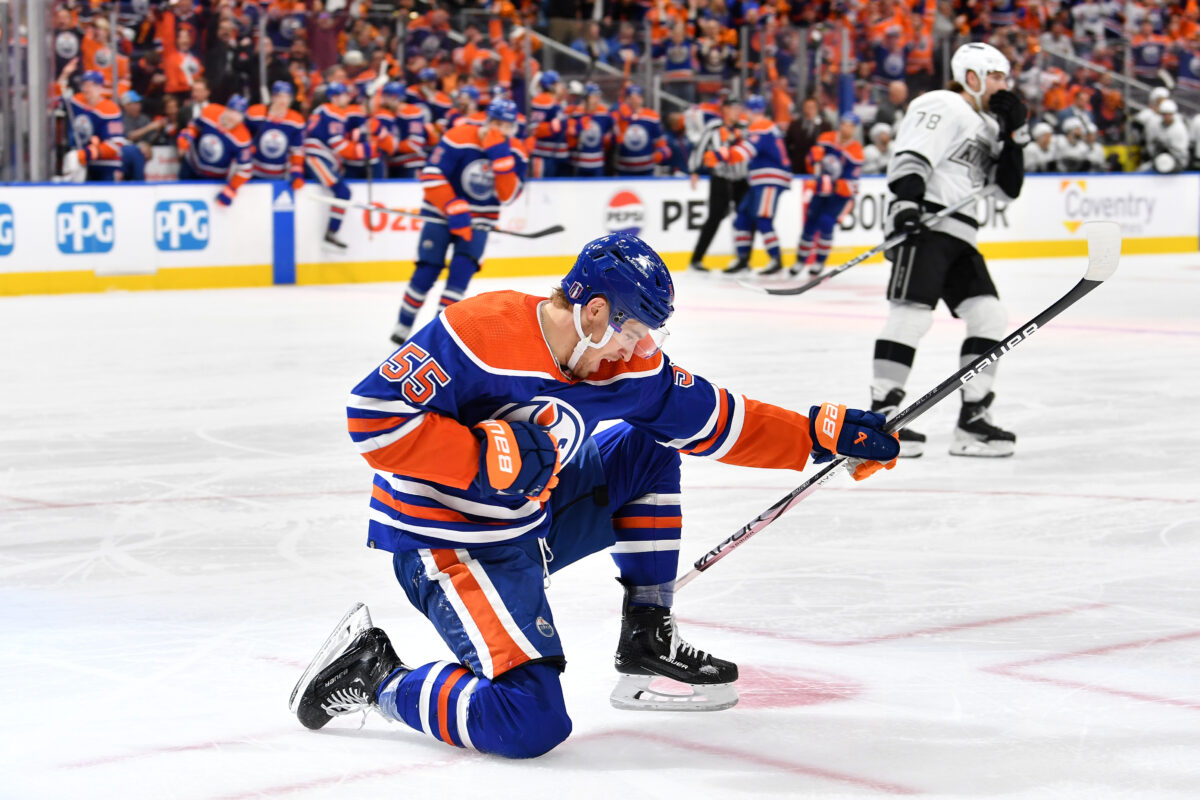The St. Louis Blues shocked the hockey world when they extended offer sheets to restricted free agents Dylan Holloway and Philip Broberg of the Edmonton Oilers. Both former first-round picks faced challenges earning regular spots in Edmonton’s lineup last season. While Broberg’s departure was more understandable given the vast compensation worth more than $9 million over two seasons, Holloway’s decision to leave such a talented forward group raised eyebrows. Now, Holloway faces the challenge of proving his decision to leave Edmonton was correct, and securing a top-six role with St. Louis would go a long way in easing any doubts.
Holloway Never Had a Chance
Throughout most of Connor McDavid’s career in Edmonton, the team’s bottom-six depth had consistently been a weakness. While the top six and power play were always one of the league’s best, the secondary lines lacked the scoring, offensive support, and consistency needed for a Stanley Cup run. That finally shifted last season, as key depth players like Ryan McLeod, Warren Foegele, and Adam Henrique played an integral role in the team’s success. As a result, Holloway never found the chemistry or trust needed to become a regular in a contending lineup.
In Holloway’s 38 NHL games last season, he received more than 14 minutes of ice time in just three games and under 10 minutes in 10 games, including several instances where he logged just one or two shifts in the third period. He also spent only three minutes on the power play all season, according to MoneyPuck.
Related: 5 St. Louis Blues Players to Watch This Preseason
For most of those 38 games, Holloway played alongside McLeod, with his third linemate frequently rotating. He was often paired with defensively-minded forwards and used in a checking role, a stark contrast to the scoring role he had played throughout his career.
What Does Opportunity Look Like for Holloway?
While it is clear that Holloway never had a true opportunity in Edmonton, what might that chance look like in St. Louis? First and foremost, he needs to see time on the power play, likely on the second unit. Holloway is too skilled to be left out, especially given that he has yet to be given a real shot to show his value on the man advantage.

At even strength, the Blues need to play Holloway alongside a play-driving scorer. Pavel Buchnevich, who has maintained a pace of nearly 30 goals and 65+ points in each of the last three seasons, would be an ideal fit on the opposite wing. Brayden Schenn, a reliable playmaking and two-way center, could complete the line. Putting Holloway in this position would set him alongside two veterans who have NHL experience and can help ease him into this elevated role.
Holloway Faces Roadblocks
While it is easy to pencil Holloway in as a second-line forward, it will create a few issues throughout the lineup. Among St. Louis’ younger forwards, Holloway will be competing for ice time with Jake Neighbours, who is aiming for a breakout season, and rookie Zack Bolduc. As a result, head coach Drew Bannister may lean towards the more familiar faces over a newcomer like Holloway.
STL, meet Dylan Holloway 🤩 #stlblues pic.twitter.com/8TMHOVt6Xt
— St. Louis Blues (@StLouisBlues) September 22, 2024
In addition to Neighbours and Bolduc, the Blues have older options in Brandon Saad, Radek Faksa, Mathieu Joseph, Alexandre Texier, and Oskar Sundqvist who each have proven experience in the NHL and were hopeful to cement the bottom six. Although Holloway was a former first-round pick, the Blues only sacrificed a third-round pick to acquire him via the offer sheet, so the organization may not feel a strong obligation to develop him into a top-six forward. This does not mean they will not work on his development, but the focus may be more on Broberg. Unfortunately, at 23 years old, keeping Holloway stuck in a bottom-six role for too long could seriously hinder his progress and be detrimental to his long-term development.
Holloway’s Ceiling & Floor
If Holloway is given the top-six opportunity outlined here, he has the potential to score close to 20 goals and 40 points. With a strong wrist shot and the benefit of playing alongside experienced NHL talent, he should find his way onto the scoresheet quite a bit, even if there are some growing pains. From there, he could develop into a winger capable of 25+ goals and 60+ points per season in his prime.
However, if the Blues place Holloway in a bottom-six role without power-play time, he could struggle to secure a regular spot in the lineup. With stiff competition for ice time, being relegated to a checking role would limit his offensive output and stall his development, leading to what could be another disappointing season.
The most realistic scenario for Holloway may be starting on the third line with gradually increasing responsibilities, eventually earning time on the second power-play unit. While this wouldn’t be disastrous in his first season with the Blues, for a team looking to build a contending forward core in the coming seasons, restricting Holloway to a bottom-six role is not an ideal long-term strategy.
